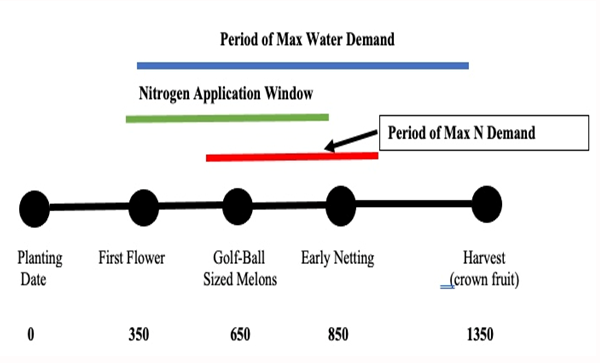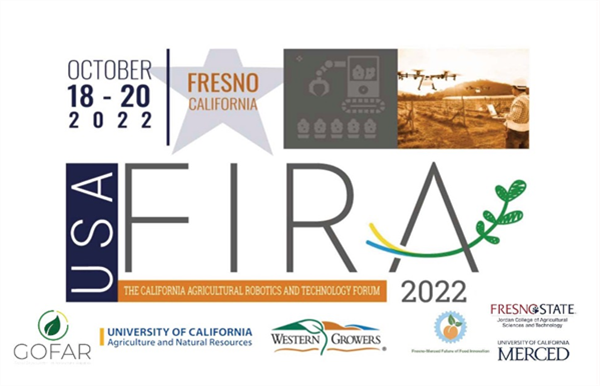May 4, 2022
Cantaloupe Nutrient & Water Demand
In a recent edition of this newsletter on 20 April 2022, I presented a cantaloupe phenological (crop growth and development) model based on heat units accumulated after planting (HUAP, 86/55 Fo thresholds) as shown in Figure 1.
The benefits of working with and using a model like this include being able to describe and predict important stages of crop growth and development (crop phenology) and harvest dates. This can also be a good tool for improving crop management (e.g., fertilization, irrigation, harvest scheduling, pest management activities, labor and machinery management, etc.).
Included in our work with the development of this phenological model, we have also conducted nutrient uptake studies and water use studies to develop a better understanding of nutrient and water demand for desert cantaloupe production (Silvertooth, 2003; Soto et al., 2006; and Soto, 2012).
Figure 2 presents the nitrogen (N) uptake and portioning patterns for desert cantaloupes (melons), Silvertooth, 2003 and Soto et al. 2006. This data describes total N uptake for cantaloupes at ~ 140 lbs. N/acre. From this data, maximum N flux (N uptake/day) period extends from early fruit development to the netting stage.
Water use by desert cantaloupe production was also measured in these studies and patterns of water use followed the crop coefficient (Kc) patterns provided by the Arizona Meteorological Network (AZMET) and conformed to the Kc values from FAO 56 (Allen et al., 1998) and Grattan et al. (1998).
Considering N uptake and water demand patterns in relation to cantaloupe crop phenology, we can insert the overlaps as shown in Figure 1, with the red and blue lines for N and water management, respectively. Maximum N demand occurs from approximately 500 to 1,000 HUAP, which coincides with primary fruit development. Accordingly, the N application window for optimum N uptake is from approximately 300 to 800 HUAP, which is from early flowering to the netting stage of the crown fruit. The N application window is recommended in advance of the optimum N uptake period to provide for N mineralization and the plant-available forms of N for plant uptake and utilization.
Considering the N application window described in Figure 1 and a maximum seasonal uptake and demand of ~ 140 lbs. N/acre, early and split applications during this period of cantaloupe crop development can help achieve optimum utilization of fertilizer N inputs.
The period of maximum water demand extends from early fruiting stages of development through the maturation of the crown fruit, 300 to 1300 HUAP.
Considering the conditions we are experiencing these days in desert crop production with water shortages and extremely high prices of fertilizers, we have an abundance of motivation to manage our crop production systems with the highest efficiency possible. Understanding crop water and nutrient demand for each crop we are working with and using that knowledge to manage our crops most effectively, is to our benefit agronomically, economically, and environmentally.
Nitrogen is the plant nutrient required in largest amounts by most non-leguminous crops and it is important for us to manage that nutrient for a crop in a careful and deliberate manner. Water and N interactions are a critical aspect of crop growth, development, and management in any system, but particularly in an irrigated crop production system. Thus, the focus offered in this article on water and N management for desert cantaloupe production.
I encourage those who are working with spring cantaloupe production this season to test and evaluate this crop phenology model, particularly in relation to nutrient and water management under field conditions with various planting dates, varieties, and soil types. We appreciate your feedback.

Figure 1. Heat Units Accumulated After Planting (HUAP, 86/55 oF)

Figure 2. Cantaloupe (melon) N uptake and partitioning patterns. (Soto, Silvertooth, and Galadima 2006). Note: kg/ha * 0.89 = lbs/acre
References:
Grattan, S.R., W. Bowers, A. Dong, R.L. Snyder, J.J. Carroll, and W. George. 1998. New crop coefficients estimate water use of vegetables, row crops. California Agriculture 52(1):16-21.https://doi.org/10.3733/ca.v052n01p16
Allen, R.G., L.S. Pereira, D. Raes, and M. Smith. 1998. Crop evapotranspiration - Guidelines for computing crop water requirements - FAO Irrigation and drainage paper 56. Food and Agriculture Organization of the United Nations. Rome (FAO). https://www.fao.org/3/x0490e/x0490e0b.htm
Silvertooth, J.C. 2003. Nutrient uptake in irrigated cantaloupes. Annual meeting, ASA-CSSA-SSSA, Denver, CO.
Soto, R. O. 2012. Crop phenology and dry matter accumulation and portioning for irrigated spring cantaloupes in the desert Southwest. Ph.D. Dissertation, Department of Soil, Water and Environmental Science, University of Arizona.
Soto-Ortiz, R., J.C. Silvertooth, and A. Galadima. 2006. Nutrient uptake patterns in irrigated melons (Cucumis melo L.). Annual Meetings, ASA-CSSA-SSSA, Indianpolis, IN.












